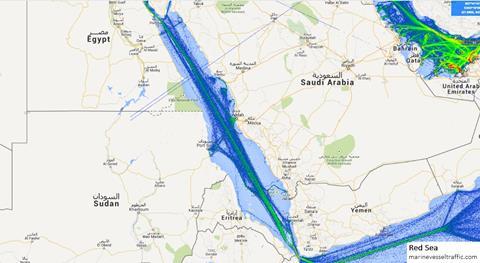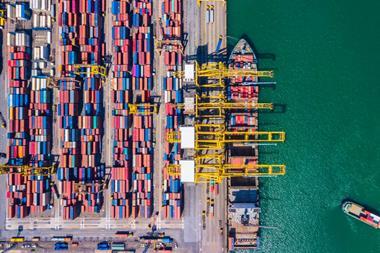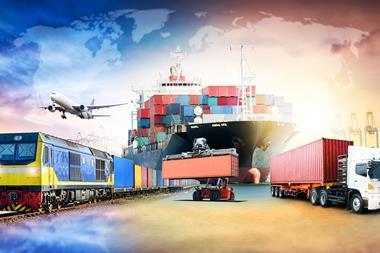As CEO of shipping giant Maersk says that supply chains are at breaking point, here’s how ports are responding and what risk managers can expect
The maritime industry is battling with increasing pressure on the global supply chain with hundreds of billions of dollars in trade at risk.
As a consequence, experts are calling for new risk management systems to be introduced.

An industry in chaos
Ports shipping firms and logistics companies are continuing to scramble to protect the global supply chain amid warnings that things are set to worsen.
Ongoing geopolitical risks have impacted transits via the Red Sea and Suez Canal while an arid rainy season has seen the Panama Canal forced to reduce the number and the size of the vessels which can transit its lock system.
The continued attacks on merchant vessels in the Red Sea has seen the world’s major shipping lines look to take the longer journey around the Cape of Good Hope adding two weeks to the average transit.
The longer transit have thrown shipping into chaos with vessels arriving later into ports only to find significant congestion resulting in far longer turnaround compounded the congestion.
Supply chains in chaos
The CEO of shipping giant Maersk says the supply chain is at breaking point.
The company said: “The fallout of the Red Sea situation is continuing to cascade across the world, creating challenges for supply chains and our customers.
“It has caused industry-wide disruptions since December 2023, forcing vessels to temporarily divert and take longer routes around the Cape of Good Hope and causing unprecedented challenges for global supply chains.”
CEO Vincent Clerc says the coming months will be challenging for carriers and businesses alike, as the Red Sea situation stretches into the third quarter of 2024.
“These disruptions, and the impact they are having on your business, is not something that I, nor any colleagues at Maersk, take lightly”
In a message to clients he added: “We are faced with these challenges together and we need to make sure that we stay close to them as we handle the new set of circumstances that continues to unfold in front of us.
“These disruptions, and the impact they are having on your business, is not something that I, nor any colleagues at Maersk, take lightly. We know it is hard. We know it is difficult for you. We know it puts you under a lot of pressure.”
Clerc explains extending rotations to travel the longer route around Africa takes two to three ships, depending on the trade in question.
“All ships that can sail and all ships that were previously not well utilised in other parts of the world have been redeployed to try to plug holes.”
“The availability of additional capacity was low to begin with and, across the industry, carriers’ ability to bring in extra tonnage has been limited,” he adds. “At the same time, demand for container transport has remained strong.
“Today, all ships that can sail and all ships that were previously not well utilised in other parts of the world have been redeployed to try to plug holes. It has alleviated part of the problem, but far from all the problems across the industry, including for Maersk.
“We are going to have in the coming month missing positions or ships that are sailing that are significant different size from what we normally would have on that string, which will also imply reduced ability for us to carry all the demand that there is.”
A global concern
Clerc says Asian exports are more impacted than Asian imports by the ongoing situation in the Red Sea.
This is primarily because Asian countries are major global exporters, and China is the largest exporter to many Asian countries. Routes between the Far East and Europe via the Suez Canal have been directly impacted, with disruptions in the Red Sea affecting most trade routes.
However, the disruptions have extended beyond Far East-Europe routes to the entire ocean network.
“Ports across Asia, including Singapore, Australia, and Shanghai, are experiencing delays as ships reroute”
“The cascading impact of these disruptions extends beyond the primary affected routes, causing congestion at alternative routes and transshipment hubs essential for trade with Far East Asia, West Central Asia, and Europe,” he adds.
“Ports across Asia, including Singapore, Australia, and Shanghai, are experiencing delays as ships reroute and schedules are disrupted, caused by ripple effects from the Red Sea.
“We are also approaching typhoon season, which is expected to impact East China and South China, creating further risks of congestion.”
Port congestion adds complications
Maritime data and analytics company Russell Group estimates $131 billion (£101 billion) in trade is at risk of being disrupted by the ongoing port congestion at the ports of Singapore, Port Klang and Tanjung Pelepas alone.
Crude Oil ($7.3 billion / £5.65 billion) and Integrated Circuit Boards ($11 billion / £8.5 billion) were the most likely to be impacted by the delays at the ports.
All three ports have faced significant congestion since the middle of June, with vessels avoiding the Red Sea. Diverted vessels have been arriving at ports, either behind schedule, or using the port as an alternative, which is creating large queues.
Singapore, because of its size and location near the Strait of Malacca has found itself a focus for many shipments, resulting in a large queue of ships waiting to enter the port.
“The spectre of port congestion has again arisen to create concern for businesses and insurers alike.”
However, to avoid these queues, many vessels have opted to use the nearby Malaysian ports of Port Klang and Tanjung Pelepas, and in doing so spreading the congestion to these ports.
Suki Basi, managing director of Russell Group adds: “These figures released by Russell show that the spectre of port congestion has again arisen to create concern for businesses and insurers alike.
“Previously, the port congestion had been linked to the COVID-19 pandemic. This time the congestion has been exacerbated by the fallout from the Red Sea attacks, with vessels using alternate ports like Singapore, Port Klang and Tanjung Pelepas to unload items, creating large delays.
“If this demand spreads to other ports, which may happen, as we move into a period when companies start ordering for the upcoming holiday season in the autumn, then businesses may find themselves struggling to source items.”
Port of Singapore operator PSA Singapore (PSA) said it has ramped up its capabilities to support increased activity and mitigate the impact of global supply chain disruptions.
“Businesses may find themselves struggling to source items.”
As a result, the average wait time at the port in recent weeks has been reduced to two days or less.
“As the various disruptions, including the Red Sea situation are still ongoing, the supply chain demand and impact remain volatile,” it added. “PSA remains committed to work alongside its customers during these uncertain times.”
Ong Kim Pong, Group CEO of PSA International adds: “PSA Singapore remains committed to meet the challenges of ongoing volatility and ensure the port’s development and handling capacity align with our customers’ needs.
“The Red Sea crisis has significantly disrupted global shipping and trade and we anticipate this challenging situation to persist for a prolonged period, potentially extending port congestion from Asia to Europe.”
Singapore’s port has seen about 90% of container vessels arriving off-schedule, compared to an average of about 77% in 2023. In addition, vessel port stays at PSA have also increased by 22% compared to the same period last year.
Calls for new risk management approaches
Director general of the Chartered Institute of Export & International Trade has called for action to speed the movement of goods and better manage supply chain risk.
Marco Forgione says: “Ships have been rerouting, adding up to two weeks transit time and significant additional fuel costs, not to mention logistical headaches for supply chains to manage. Demand for rail and air freight has increased as businesses look for alternative ways to move their goods.”
“This weaponisation of trade routes will continue for some time”, he continues as nations, politicians, military planners as well as business leaders “tangle with the Gordian knot of conflict”.
“It is clear that all nations have to shift away from highly fragile supply chains and sourcing patterns”
Forgione adds “longer-term solutions” need to be implemented to minimise the disruption, and support risk managers.
“First, the digitalisation of supply chains. Updating old paper-based systems helps logistics companies, port authorities and hauliers have greater visibility and reduce friction in the supply chain,” he explains.
“Secondly, investing in the expansion of physical trade routes in other parts of the world will reduce the reliance on the route through the Red Sea.
“It is clear that all nations have to shift away from highly fragile supply chains and sourcing patterns to build resilient, anti-fragile systems. All of this will require time, significant resources and new approaches to manufacturing and inventory management.”














No comments yet